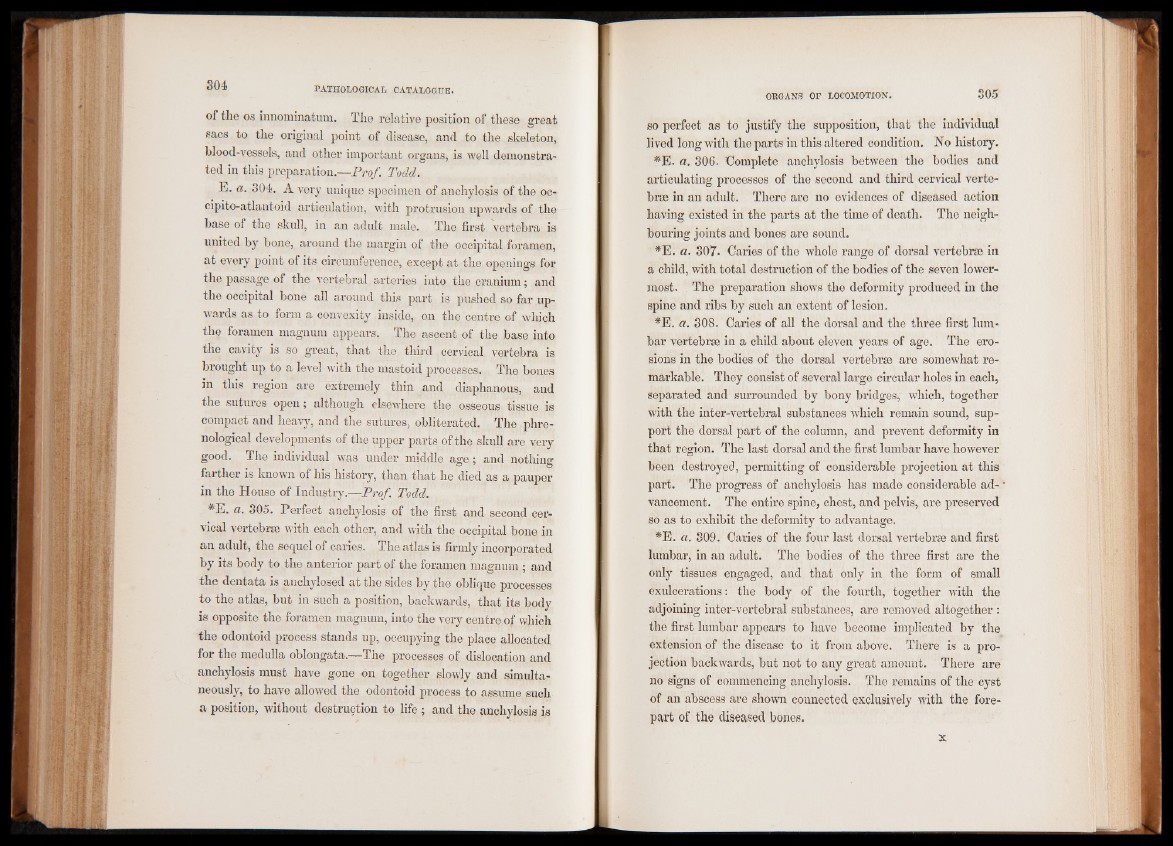
of the os innominatum. The relative position of these great
sacs to the original point of disease, and to the skeleton,
blood-vessels, and other important organs, is well demonstrated
in this preparation.—Prof. Todd.
E. a. 304. A very unique specimen of anchylosis of the oc-
cipito-atlantoid articulation, with protrusion upwards of the
base of the skull, in an adult male. The first vertebra is
united by bone, around the margin of the occipital foramen,
at every point of its circumference, except at the openings for
the passage of the vertebral arteries into the cranium; and
the occipital bone all around this part is pushed so far upwards
as to form a convexity inside, on the centre of which
the foramen magnum appears. The ascent of the base into
the cavity is so great, that the third cervical vertebra is
brought up to a level with the mastoid processes. The bones
in this region are extremely thin and diaphanous, and
the sutures open; although elsewhere the osseous tissue is
compact and heavy, and the sutures, obliterated. The phrenological
developments of the upper parts of the skull are very
good. The individual was under middle age; and nothing
farther is known of his history, than that he died as a pauper
in the House of Industry.—Prof. Todd.
#E. a. 305. Perfect anchylosis of the first and second cervical
vertebrae with each other, and with the occipital bone in
an adult, the sequel of caries. The atlas is firmly incorporated
by its body to the anterior part of the foramen magnum ; and
the dentata is anchylosed at the sides by the oblique processes
to the atlas, but in such a position, backwards, that its body
is opposite the foramen magnum, into the very centre of which
the odontoid process stands up, occupying the place allocated
for the medulla oblongata.—The processes of dislocation and
anchylosis must have gone on together slowly and simultaneously,
to have allowed the odontoid process to assume such
a position, without destruction to life ; and the anchylosis is
so perfect as to justify the supposition, that the individual
lived long with the parts in this altered condition. No history.
*E. a. 306. Complete anchylosis between the bodies and
articulating processes of the second and third cervical vertebrae
in an adult. There are no evidences of diseased action
having existed in the parts at the time of death. The neighbouring
joints and bones are sound.
*E. a. 307- Caries of the whole range of dorsal vertebrae in
a child, with total destruction of the bodies of the seven lowermost.
The preparation shows the deformity produced in the
spine and ribs by such an extent of lesion.
*E. a. 308. Caries of all the dorsal and the three first lumbar
vertebrae in a child about eleven years of age. The erosions
in the bodies of the dorsal vertebrae are somewhat remarkable.
They consist of several large circular holes in each,
separated and surrounded by bony bridges, which, together
with the inter-vertebral substances which remain sound, support
the dorsal part of the column, and prevent deformity in
that region. The last dorsal and the first lumbar have however
been destroyed, permitting of considerable projection at this
part. The progress of anchylosis has made considerable advancement.
The entire spine, chest, and pelvis, are preserved
so as to exhibit the deformity to advantage.
*E. a. 309. Caries of the four last dorsal vertebrae and first
lumbar, in an adult. The bodies of the three first are the
only tissues engaged, and that only in the form of small
exulcerations: the body of the fourth, together with the
adjoining inter-vertebral substances, are removed altogether :
the first lumbar appears to have become implicated by the
extension of the disease to it from above. There is a projection
backwards, but not to any great amount. There are
no signs of commencing anchylosis. The remains of the cyst
of an abscess are shown connected exclusively with the forepart
of the diseased bones.